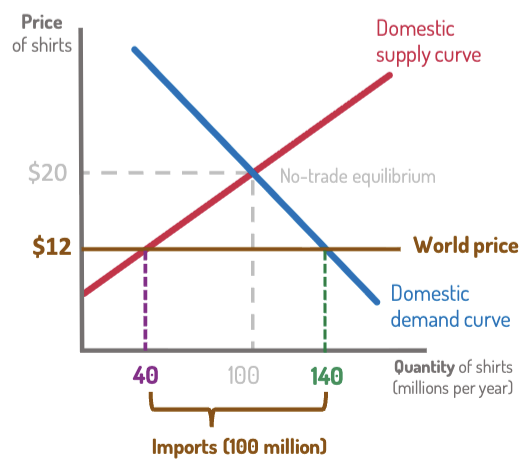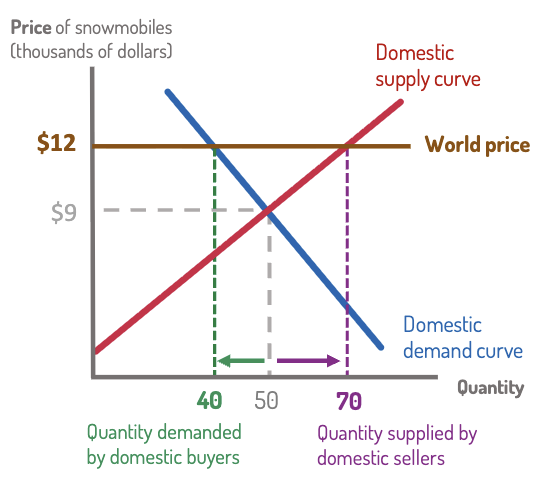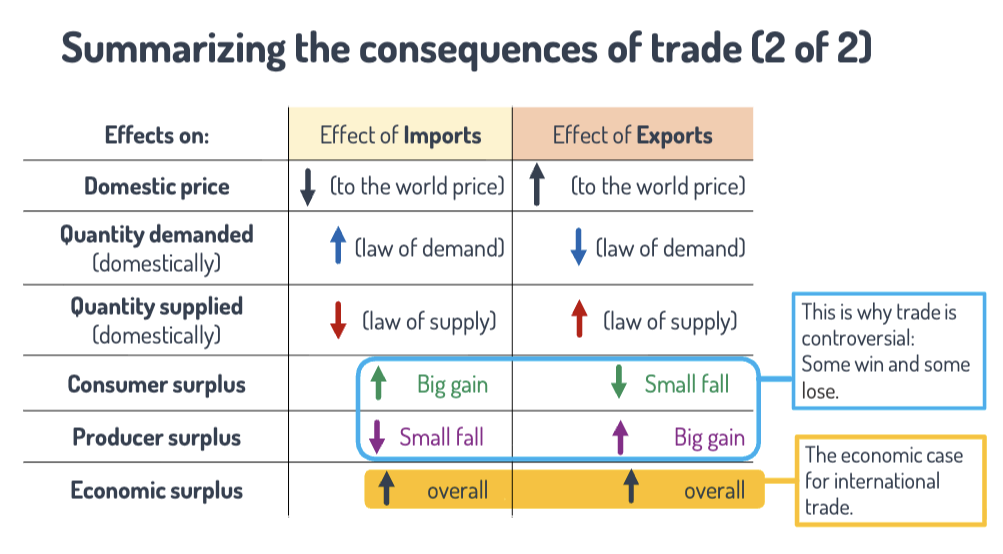Econ 102 - Chapter 9 - International Trade
1/22
There's no tags or description
Looks like no tags are added yet.
Name | Mastery | Learn | Test | Matching | Spaced |
|---|
No study sessions yet.
23 Terms
Comparative advantage (foundation of international Trade) explains why nations trade
Each country produces what it is relatively best at (lowest opportunity cost) and trades for the rest.
Result: Everyone can consume more than they could in isolation — borders don’t matter to the logic of comparative advantage
import
Buying goods/services from foreign sellers
ex: The U.S. buys electronics from Japan.
Who benefits?
Buyers (consumers) b/c lower price
export
Selling goods/services to foreign buyers
ex: The U.S. sells airplanes to Europe
Who benefits?
producers (suppliers)
Trade Costs
Extra costs of buying or selling internationally instead of domestically.
Examples:
Shipping fees, customs delays
Import/export taxes (tariffs)
Language or time zone barriers
Foreign legal regulation
Lower trade costs → more international trade
Trade Decision Rules
Import if: foreign price + trade costs < domestic price
Export if: foreign price − trade costs > domestic price
Globalization
The increase in global economic, cultural, and political integration
Why it’s growing:
Trade agreements reduce tariffs
Better transportation and communication
Internet & digital goods (low trade costs
Sources of Comparative Advantage
Abundant Inputs:
Geography and resources → Saudi oil, Canadian wood, Bangladeshi labor.
Specialized Skills (Learning by Doing):
Switzerland → watches
France/Wisconsin → cheese
U.S. → movies, tech.
Mass Production (Economies of Scale):
IKEA produces bookcases every 5 seconds using robots & bulk wood purchasing.
Opposites attract: trading partners with different resources gain the most.
Produce what you are relatively good at
World Supply
Total produced globally at each price.
World Demand
Total bought globally at each price.
World Price
The international equilibrium price (where global supply = demand).
Imports — Step-by-Step
Example: T-shirt market, domestic price = $20, world price = $12.
New Price:
Price falls to world price ($12).Quantities:
Domestic supply ↓ (40 million)
Domestic demand ↑ (140 million)
Imports:
Gap filled by imports = 140 − 40 = 100 million shirts
Results:
Buyers gain → lower prices, more choices
Domestic sellers lose → lower profits
Total economic surplus increases

Exports — Step-by-Step
Example: Snowmobile market, domestic price = $9, world price = $12.
New Price:
Price rises to world price ($12).Quantities:
Domestic supply ↑ (70k)
Domestic demand ↓ (40k)
Exports:
Gap = 70 − 40 = 30k snowmobiles
Results:
Producers gain (higher price, more sold)
Consumers lose (pay more)
Total economic surplus still increases

Summarizing Imports and exports

What happens to economic surplus after importing or exporting internationally?
an overall gain (an increase)
The Debate About International Trade
Arguments (have claims and counters)
National Security
Infant Industries
Unfair competition (Dumping)
Minimum Standards
Save domestic Jobs
(for more info, look at Chat or slides)
Tools of Trade Policy
Tariff
Red Tape
Import quotas
Exchange Rate Manipulation
Tariff
A tax on imported products.
increase trade costs
Effects:
Raises prices, reduces imports, raises gov revenue
Red Tape
Extra bruactractic barriers
Effect:
Reduce international trade but does not raise revenue for domestic government
Import Quotas
Limits on imports
Effects:
Reduce international trade just as tariffs do (exact same price and quantity outcomes) but does not raise government revenue.
Exchange Rate Manipulation
Adjusting currency values
Effects:
A country can use this tool to increase its exports and reduce its imports.
Exports ↑, imports ↓
Tariffs — Step-by-Step Example
Free trade: World price = $12.
Imports = 100 million shirts.Tariff = $4 → new price = $16.
Effects:
Imports fall (gap shrinks).
Domestic producers gain slightly.
Consumers lose a lot (higher prices).
Government earns revenue = tariff × imports.
Deadweight loss: total surplus falls.
Tariffs = higher prices, less trade, lower efficiency.

Exchange Rate Manipulation Example
Scenario:
1 USD = 6 yuan → Boeing plane = ¥360M
China devalues yuan → 1 USD = 7 yuan → same plane = ¥420M
Results:
Chinese goods cheaper abroad → exports ↑
U.S. goods more expensive in China → imports ↓
U.S. producers lose; Chinese exporters win.
Effect on Income Inequality
Exports (high-skill goods):
→ Raises demand for educated workers → higher salaries.Imports (low-skill goods):
→ Reduces demand for low-skill workers → lower wages.
Result: Trade increases total wealth but widens income inequality.